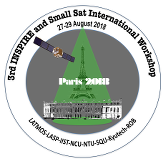Speaker
Prof.
Amal Chandran
(Nanyang Technological University & LASP)
Description
The Regional Ionosphere Mapping and Autonomous Uplink (RIMAU) mission is a constellation of six CubeSats in an equatorial orbit, making Radio Occultation (RO) measurements of the atmosphere and in-situ Ionospheric measurements to characterize the ionosphere over equatorial South-East Asia in near real time. RIMAU builds on the success of the VELOX-CI mission which carried a COTS NOVATEL GPS receiver and have been operating successfully since December 2015. The Satellite Research Centre at Nanyang Technological University in Singapore has designed, built, tested and operated 7 satellites so far ranging from 1U cubesat to 135 kg VELOX-CI microsatellite. RIMAU will carry GPS receivers for RO and an Ionospheric payload consisting of a planar Langmuir probe, retarding potential analyser and Ion trap/drift meter. RIMAU-1 is scheduled to be in operation by 2020 with the full constellation scheduled for flight by 2021. A secondary objective of RIMAU is to provide a Low Earth Orbiting nanosatellite platform for communication with remote sensors in the region. RIMAU-I will demonstrate communication with remote water sensors monitoring water pollutants and uplink from ground based GPS sensors to adjust the sampling rate for the Ionospheric probe during periods of high scintillation. Understanding the occurrence and impact of Ionospheric irregularities is critically needed for equatorial countries like Singapore. Forecasting Ionospheric plasma bubbles and their day-to-day variability is one of the long-standing frontier challenges in space physics. In this paper, we present a novel idea to combine ground based and space based Ionospheric observations to monitor in near-real time the Ionosphere over the Singapore region to characterize Ionospheric disturbances and their impact on communication and navigation systems. The main data products from these measurements will be vertical profiles of the Total Electron Content (TEC) in the ionosphere, atmospheric temperature and humidity profiles in the troposphere. RIMAU TEC measurements will be combined with ground based TEC measurements from ~ 60 GPS receivers in the SE Asia region, operated by the Earth Observatory of Singapore to produce 3D maps of the Ionosphere. The outcomes from the study will be a space weather ‘now-cast’ system for the region, which has applications to minimize impacts to a number of critical applications, such as point positioning and real-time kinematics (i.e., the location of moving vehicles), which are particularly relevant to the aviation and maritime industry and the emerging autonomous vehicle industry.
Primary author
Prof.
Amal Chandran
(Nanyang Technological University & LASP)

